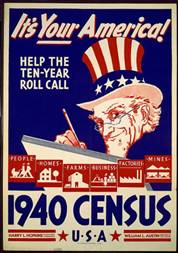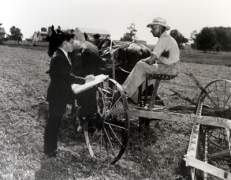Last week, on April 2, 2012, the 1940 United States census was released to the public in digital format by the National Archives in conjunction with the U.S Census Bureau at http://1940census.archives.gov
Image: 1940 Census Poster urging Americans to “Help the Ten-Year Roll Call”. Source:U.S.Census Bureau
Reports National Public Radio:
Veiled in secrecy for 72 years because of privacy protections, the 1940 U.S. census is the first historical federal decennial survey to be made available on the Internet initially rather than on microfilm.
In a great example of a private/public partnership, Archives.com’s parent company partnered with the National Archives to provide the public with free digital access to the 1940 Federal Population Census.
Miriam Kleiman, spokeswoman for the U.S. National Archives, told The Associated Press that the Archives’ 1940 census site registered more than 22 million hits in just four hours from almost 2 million users on its very first day of release. It is extremely popular already with librarians, researchers and genealogists researching their family tree.
Data from the Great Depression
Archivist Connie Potter, in an entertaining video about the Archives’ digitization project, explains that the reason this census is so amazing is because it describes “the country during the Great Depression. It reflects all of the economic dislocation, how many people were immigrants, how many people had what level of education.”
Last week’s release of digitized information covers detailed records on 132 million people living in the United States at the end of the Depression and a year before Pearl Harbor.
The census data was transferred to microfilm during World War II, and in 2009, National Archives personnel began digitizing those records, culminating in the release of the database last week.
Over 3.9 million images were digitized, providing a bonanza for researchers.
Some interesting facts about the 1940 Census
 Image: An enumerator interviews a woman with her 10 children around her for the 1940 census. Source: National Archives at College Park
Image: An enumerator interviews a woman with her 10 children around her for the 1940 census. Source: National Archives at College Park
The Census Bureau began the 1940 census with extensive long-term planning, recruiting and training. Back in 1940, about 120,000 census-takers, called enumerators, spread out across the U.S. and territories, going door-to-door to interview families.
Enumerators both then and now can face challenging situations when gathering the data to tabulate the census, from trudging through fields or mushing a dog sled across the snow.
Image: Rural visit by a U.S. Census taker in connection with the 16th decennial census of 1940 Source:  Library of Congress image number LC-USZ62-91199
Library of Congress image number LC-USZ62-91199
Image: The Alaska Territory saw the census enumerator arrive in his dog sled, 1940 – 1941 Source: National Archives Research Catalog
Questions from the 1940 Census
It’s interesting to note the questions that were asked on the 1940 census form. One of the fifty questions the enumerators asked Americans in 1940 reflected the more formal societal structures of the time: “What was the Relationship of this person to the head of the household, as wife, daughter, father, mother-in-law, grandson, lodger, lodger’s wife, servant, hired hand, etc.?”
Another question was very relevant for a Depression-era nation where children as young as 14 still worked, and millions of out-of-work Americans were given “public emergency” jobs around the country under Franklin Roosevelt’s New Deal programs. One was the Works Project Administration (originally the Works Progress Administration) or WPA, which was the “largest and most ambitious New Deal agency and employed millions of unskilled workers to carry out public works projects,including the construction of public buildings, roads and dams, as well as operating large arts, drama, media, and literacy projects.”
Image: WPA Federal Arts poster. Source: Smithsonian Archives of American Art
 Another New Deal program mentioned in the census was the Civilian Conservation Corps or CCC . It was designed to provide employment mostly for young men in relief families who had difficulty finding jobs during the Great Depression (there were separate programs for veterans and Native Americans), while at the same time implementing a general natural resource conservation program in every state and territory for the “conservation and development of natural resources in rural lands” owned by federal, state and local governments. Many trees were planted and national and state parks built and preserved by the CCC.
Another New Deal program mentioned in the census was the Civilian Conservation Corps or CCC . It was designed to provide employment mostly for young men in relief families who had difficulty finding jobs during the Great Depression (there were separate programs for veterans and Native Americans), while at the same time implementing a general natural resource conservation program in every state and territory for the “conservation and development of natural resources in rural lands” owned by federal, state and local governments. Many trees were planted and national and state parks built and preserved by the CCC.
Image: Illinois CCC recruiting poster. Source: Archives.gov
Another youth-focused program referenced was the National Youth Administration or NYA that focused on providing work and education for young Americans between the ages of 16 and 25.
Thus, it makes sense that this 1940 census question asked “Persons 14 Years Old and Over” to classify their employment status during the time of the census-taking (March 24-30, 1940) as follows:
- Was this person AT WORK for pay or profit in private or non-emergency Government work during week of March 24-30? (Yes or No).
- If not, was he at work on, or assigned to, public EMERGENCY WORK (WPA, NYA, CCC, etc.) during week of March 24-30? (Yes or No).
How to Use the 1940 Census
Even for those not steeped in genealogy research will find it thrilling, like I do, to see the excitement build over the release of these images. It might be fun to look up my ancestors because I know my grandfather worked for the W.P.A. I’m also interested in looking at the various trends and metrics available on housing to see if there is any correlation to the current economic situations.
Visit the National Archives pages to see the various resource location aids, enumerator training videos, and question templates that have been gathered for your use. Based on the times, there were specific instructions for enumerators to get a count of temporary housing such as huts, tents, and cabins as of a point in time. Here’s one bit of instruction to help clarify how to count the large transient population: “Persons in hotels, tourist or trailer camps, missions, and cheap one night lodging houses (flophouses) will all be enumerated as of the evening of April 8th”.
Help Tag the Images
The Census Bureau is appealing to the public for help indexing and meta tagging the images. This is a genealogy crowdsourcing project to ensure the 3.8 million images are indexed and freely searchable online. You, too, can register to be a 1940 Census Blog Ambassador and get a nifty badge for your page!
You can follow the 1940 Census via Twitter at: #1940Census #Genealogy #history.
How can you get other Census Bureau publications today?
The release of the historic images will be made at 1940census.archives.gov.
For those interested in more current information, take a look at the resources in GPO’s U.S. Government Bookstore. The subscription series help keep you updated on the Census and Population statistics as they are released.
- Buy these best-selling Census publications online 24/7 at GPO’s Online Bookstore:
- Browse our entire collection of Census publications at the GPO Online Bookstore by searching for “census”.
- Statistical Abstract of the United States 2012 (Hardcover) and Statistical Abstract of the United States 2012 (Paperback). The Statistical Abstract of the United States, published since 1878, is the best-selling statistical reference book for researchers, education and commerce. It includes a summary of statistics on the social, political, and economic organization of the United States from the Census Bureau and other sources they compile. It is designed to serve as a convenient volume for statistical reference and as a guide to other statistical publications and sources.
- Census Atlas of the United States (Hardcover) This is the first general population and housing statistical atlas published by the U.S. Census Bureau since the 1920s.
- Income, Poverty & Health Insurance 2010
- Current Housing Reports H-130, Market Absorption of Apartments
- Current Population Reports Series: Population Characteristics; Special Studies; and Consumer Income
- Current Population Reports: Series P-70, Household Economic Studies
- Buy them at GPO’s retail bookstore at 710 North Capitol Street NW,Washington, DC 20401. Open Monday-Friday, 9am to 4pm, except Federal holidays. Call 1.(202) 512-0132 for more information.
- Find them in a Federal Depository Library.
Guest blogger: Nancy Faget, one of our federal librarians in GPO’s Library Services & Content Management Division who writes often about NASA “rocket scientists” and digital innovations in the library field.




very interesting article,thanks for sharing.:)
LikeLike
I was not aware of that in the past before!
LikeLike
So, why is Elvis Presley listed as Eljzs in the 1940 Census?
LikeLike
Sounds like a great question for the Census Bureau folks! 😉
LikeLike
I read this article fully concerning the comparison of latest and previous technologies; it’s an amazing article.
LikeLike
WordPress Developer…
[…]1940 Census Goes Digital « Government Book Talk[…]…
LikeLike
[…] Read entire Government Book Talk Article […]
LikeLike
If I can be of help. In 1940, I was 1 year old in St, Louis somewhere.
LikeLike
Valerie- You should be sure to visit the 1940 Census web site and sign up to help them tag images!
LikeLike